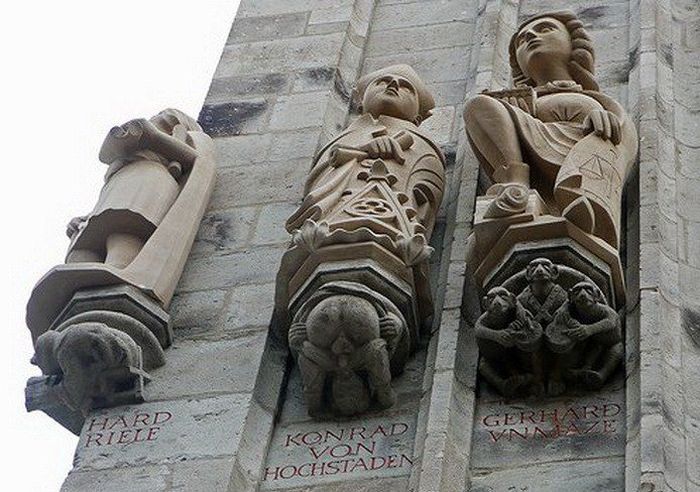|
|
The City Hall, Cologne, Germany
|
The City Hall is located on the site of the former Ancient Roman Praetorium, which until the year 475 was seat of the Roman Governor of Germania Inferior. Merovingian kings are known to have used the praetorium as a regia until 754, but the building was ultimately destroyed by an earthquake in the late 8th century. Under Hildebold of Cologne, the city was elevated from a bishop's to an archbishop's see in 795, and the area around the former praetorium has become home to both a group of wealthy Patrician merchants and Cologne's Jewish community – many of whom under immunity of the king.
With Saint Bruno the Great, brother of Emperor Otto I, becoming archbishop in 953, the Ottonian dynasty established a secular government by an ecclesiastic archbishop. This abundance of power in Medieval Europe was in stark confrontation to the emerge of emancipating burghers: armed conflicts in 1074 and 1096 were followed by the formation of a commune and first municipal structures as a basis for urban autonomy. In order to consolidate their economic and political rights, Cologne burghers established fraternities and trade guilds (most notably the Richerzeche). In the 1106 war of succession between Emperor Henry V and his father Emperor Henry IV, they took deliberate opposition to the archbishop, after which they gained benefit in regards to the city's territorial expansion over the following years. As – at the time – one of Europe's busiests trading ports and largest city in Germany, the population of Cologne gradually changed from a mainly feudal society to free citizens; the coat of arms of Cologne, first mentioned in 1114, is Europe's oldest municipal coat of arms. Documents from the years 1135 and 1152, recorded "a house in which citizen convene", referring to the first established council hall, at the location of today's town hall.
By 1180, the citizens of Cologne won a legal battle against Philip I, Archbishop of Cologne, for another extension of Cologne's city walls. With the Battle of Worringen fought in 1288, Cologne became independent from the Electorate and on 9. September 1475 officially gained Imperial immediacy as a free imperial city. In 1388 Pope Urban VI signed the charter for the University of Cologne, Europe's first university to have been established by citizenry. On 14. September 1396 the constitution of Cologne came into effect and the Cologne gaffs and guilds (Gaffeln and Zünfte) assumed power in the council. Following the tradition of Roman consuls, the council was headed by two elected Burgomasters (Mayors) until the year 1797, when council and constitution were replaced by the Napoleonic and later code civil. Since 1815 the city council is led by one Oberbürgermeister (Lord Mayor).
|
|









